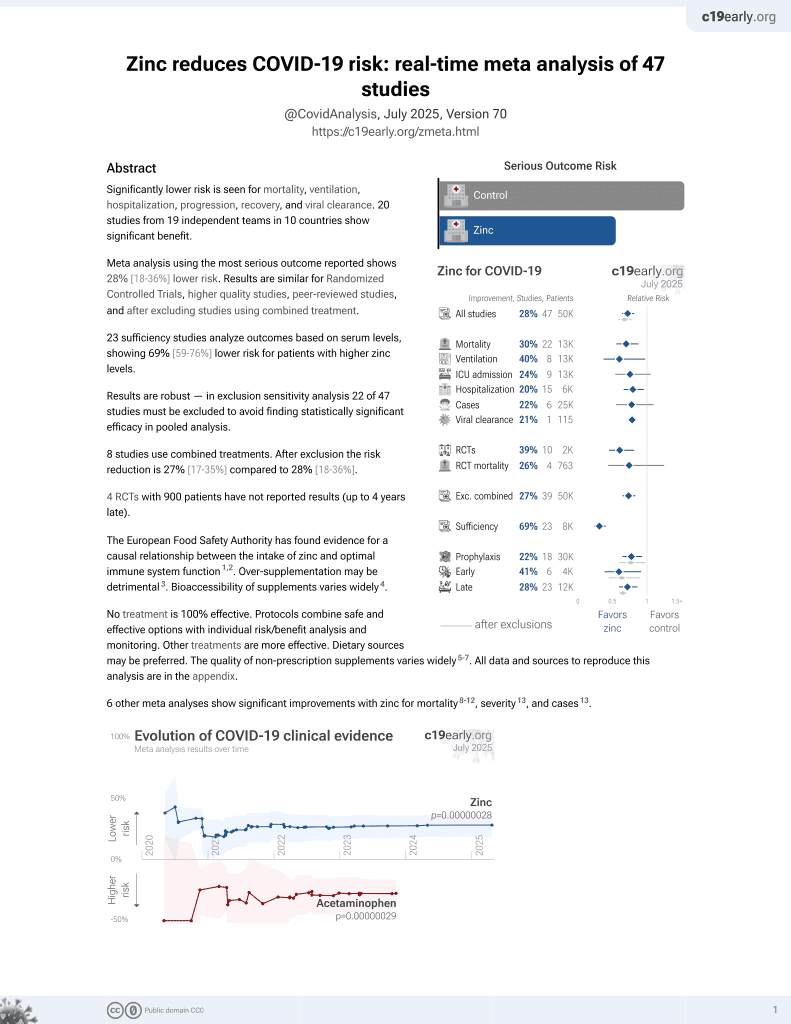
Zinc adjuvant treatment in SARS-CoV-2: a randomized clinical trial
et al., Journal of Trace Elements in Medicine and Biology, doi:10.1016/j.jtemb.2025.127778, MARZINC, NCT05778383, Apr 2025 (preprint)
Zinc for COVID-19
2nd treatment shown to reduce risk in
July 2020, now with p = 0.00000028 from 47 studies, recognized in 23 countries.
No treatment is 100% effective. Protocols
combine treatments.
6,300+ studies for
210+ treatments. c19early.org
|
RCT 71 hospitalized COVID-19 patients showing significantly lower disease progression with zinc treatment. The zinc group also demonstrated shorter mean recovery time and greater WHO scale improvement at day 14. Antibody levels were higher in the standard care group, which may be a result of greater viral replication without treatment. The control arm had a slightly higher baseline median WHO score, a potential confounder.
|
risk of death, 67.0% lower, RR 0.33, p = 0.49, treatment 0 of 35 (0.0%), control 1 of 34 (2.9%), NNT 34, relative risk is not 0 because of continuity correction due to zero events (with reciprocal of the contrasting arm).
|
|
risk of progression, 75.7% lower, RR 0.24, p = 0.045, treatment 2 of 35 (5.7%), control 8 of 34 (23.5%), NNT 5.6.
|
|
risk of no recovery, 40.1% lower, HR 0.60, p = 0.08, treatment 35, control 34, inverted to make HR<1 favor treatment, clinical recovery, Cox proportional hazards.
|
|
risk of no recovery, 42.3% lower, HR 0.58, p = 0.06, treatment 35, control 34, inverted to make HR<1 favor treatment, WHO scale, Cox proportional hazards.
|
| Effect extraction follows pre-specified rules prioritizing more serious outcomes. Submit updates |
Gómez-Zorrilla et al., 22 Apr 2025, Randomized Controlled Trial, Spain, peer-reviewed, mean age 52.9, 15 authors, study period 10 May, 2021 - 31 December, 2021, trial NCT05778383 (history) (MARZINC).
Zinc adjuvant treatment in SARS-CoV-2: A randomized clinical trial
Journal of Trace Elements in Medicine and Biology, doi:10.1016/j.jtemb.2025.127778
Introduction: Zinc is a trace element with a key role in immune function and has demonstrated antiviral and antiinflammatory properties. Low plasma zinc levels have been associated with poor outcomes in COVID-19. This study aims to evaluate the efficacy and safety of zinc supplementation as an adjuvant therapy in hospitalized patients with COVID-19. Methods: A single-center, randomized, open-label clinical trial between May and December 2021. Adults hospitalized with confirmed COVID-19 requiring hospitalization were randomized 1:1 to receive standard of care (SoC) with or without oral zinc acetate (90 mg/day) for 14 days. The primary endpoint was disease progression, defined as critical care requirement (ICU admission) or death. Secondary outcomes included time to clinical recovery, hospital length of stay, WHO clinical scale improvement, inflammatory markers, antibody response, and safety. Results: Seventy-one patients were randomized (35 zinc versus 34 SoC). Disease progression occurred in 5.7 % of the zinc group versus 23.5 % in the SoC group (OR 0.21, 95 %CI = 0.03-0.96,). Mean recovery time was significantly shorter in the zinc group (7.4 ± 6.1 versus 13.1 ± 9.7 days, p = 0.006) and a trend to a faster recovery was observed in the Cox proportional hazards model in the intervention group HR of 1.670 (95 % CI: 0.948-2.942), p = 0.076. WHO scale improvement attaining a < 1 points at day 14 was greater in the zinc group (74.3 % versus 42.4 %, p = 0.009). Antibody levels were higher in the SoC group at days 14 and 28. No adverse events were attributed to zinc. Conclusions: Adjunctive zinc supplementation to standard of care reduced disease progression and showed a trend to accelerated clinical recovery in hospitalized COVID-19 patients, supporting the potential role of zinc in managing viral respiratory infections.
Declaration of Competing Interest None of the authors have a conflict of interest to disclose.
Appendix A. Supporting information Supplementary data associated with this article can be found in the online version at doi:10.1016/j.jtemb.2025.127778.
References
Badriyah, Briggs, Meredith, Jarvis, Schmidt et al., Decision-tree early warning score (DTEWS) validates the design of the National Early Warning Score (NEWS), Resuscitation
Baiocchi, Vojdani, Rosenberg, Vojdani, Halpert et al., Cross-sectional analysis reveals autoantibody signatures associated with COVID-19 severity, J. Med. Virol
Ben Abdallah, Mhalla, Trabelsi, Sekma, Youssef et al., Twice-daily oral zinc in the treatment of patients with coronavirus disease 2019: a randomized double-blind controlled trial, Clin. Infect. Dis
Chen, Wu, Guo, Cao, Huang et al., Clinical and immunological features of severe and moderate coronavirus disease 2019, J. Clin. Invest
Gammoh, Rink, Zinc in infection and inflammation, Nutrients
Hemilä, Zinc lozenges and the common cold: a meta-analysis comparing zinc acetate and zinc gluconate, and the role of zinc dosage, JRSM Open
Hunter, Arentz, Goldenberg, Yang, Beardsley et al., Zinc for the prevention or treatment of acute viral respiratory tract infections in adults: a rapid systematic review and meta-analysis of randomised controlled trials, BMJ Open
Li, Luo, Liang, Circulating trace elements status in COVID-19 disease: a meta-analysis, Front. Nutr
Partap, Sharma, Marathe, Wang, Shaikh et al., Vitamin D and zinc supplementation to improve treatment outcomes among COVID-19 patients in India: results from a double-blind randomized Placebocontrolled trial, Curr. Dev. Nutr
Prasad, Discovery of human zinc deficiency: its impact on human health and disease, Adv. Nutr
Read, Obeid, Ahlenstiel, Ahlenstiel, The role of zinc in antiviral immunity, Adv. Nutr
Rheingold, Raval, Gordon, Hardigan, Zinc supplementation associated with a decrease in mortality in COVID-19 patients: a meta-analysis, Cureus
Schulz, Altman, Moher, CONSORT 2010 statement: updated guidelines for reporting parallel group randomised trials, BMJ
Vogel-González, Talló-Parra, Herrera-Fernández, Pérez-Vilaró, Chillón et al., Low zinc levels at admission associates with poor clinical outcomes in SARS-CoV-2 infection, Nutrients
Xu, Liu, Zou, Luo, Wu et al., Hypozincemia in COVID-19 patients correlates with stronger antibody response, Front. Immunol
DOI record:
{
"DOI": "10.1016/j.jtemb.2025.127778",
"ISSN": [
"0946-672X"
],
"URL": "http://dx.doi.org/10.1016/j.jtemb.2025.127778",
"alternative-id": [
"S0946672X25001919"
],
"article-number": "127778",
"assertion": [
{
"label": "This article is maintained by",
"name": "publisher",
"value": "Elsevier"
},
{
"label": "Article Title",
"name": "articletitle",
"value": "Zinc adjuvant treatment in SARS-CoV-2: A randomized clinical trial"
},
{
"label": "Journal Title",
"name": "journaltitle",
"value": "Journal of Trace Elements in Medicine and Biology"
},
{
"label": "CrossRef DOI link to publisher maintained version",
"name": "articlelink",
"value": "https://doi.org/10.1016/j.jtemb.2025.127778"
},
{
"label": "Content Type",
"name": "content_type",
"value": "article"
},
{
"label": "Copyright",
"name": "copyright",
"value": "© 2025 The Author(s). Published by Elsevier GmbH."
}
],
"author": [
{
"affiliation": [],
"family": "Gómez-Zorrilla",
"given": "Silvia",
"sequence": "first"
},
{
"affiliation": [],
"family": "Sendra",
"given": "Elena",
"sequence": "additional"
},
{
"affiliation": [],
"family": "Du",
"given": "Juan",
"sequence": "additional"
},
{
"affiliation": [],
"family": "Espona",
"given": "Mercé",
"sequence": "additional"
},
{
"affiliation": [],
"family": "Fierro-Villegas",
"given": "Alejandro",
"sequence": "additional"
},
{
"affiliation": [],
"family": "Siverio",
"given": "Ana",
"sequence": "additional"
},
{
"affiliation": [],
"family": "Rodriguez-Alarcón",
"given": "Alicia",
"sequence": "additional"
},
{
"affiliation": [],
"family": "Castañeda",
"given": "Silvia",
"sequence": "additional"
},
{
"affiliation": [],
"family": "López Montesinos",
"given": "Inmaculada",
"sequence": "additional"
},
{
"affiliation": [],
"family": "Plata",
"given": "Cristina",
"sequence": "additional"
},
{
"affiliation": [],
"family": "Arrieta-Aldea",
"given": "Itziar",
"sequence": "additional"
},
{
"affiliation": [],
"family": "Soldado-Folgado",
"given": "Jade",
"sequence": "additional"
},
{
"affiliation": [],
"family": "García-Giralt",
"given": "Natalia",
"sequence": "additional"
},
{
"affiliation": [],
"family": "Vicente",
"given": "Rubén",
"sequence": "additional"
},
{
"ORCID": "https://orcid.org/0000-0002-9794-9161",
"affiliation": [],
"authenticated-orcid": false,
"family": "Güerri-Fernández",
"given": "Robert",
"sequence": "additional"
}
],
"container-title": "Journal of Trace Elements in Medicine and Biology",
"container-title-short": "Journal of Trace Elements in Medicine and Biology",
"content-domain": {
"crossmark-restriction": true,
"domain": [
"elsevier.com",
"sciencedirect.com"
]
},
"created": {
"date-parts": [
[
2025,
10,
10
]
],
"date-time": "2025-10-10T04:46:17Z",
"timestamp": 1760071577000
},
"deposited": {
"date-parts": [
[
2025,
10,
12
]
],
"date-time": "2025-10-12T00:25:10Z",
"timestamp": 1760228710000
},
"indexed": {
"date-parts": [
[
2025,
10,
13
]
],
"date-time": "2025-10-13T01:01:28Z",
"timestamp": 1760317288737,
"version": "build-2065373602"
},
"is-referenced-by-count": 0,
"issued": {
"date-parts": [
[
2025,
12
]
]
},
"language": "en",
"license": [
{
"URL": "https://www.elsevier.com/tdm/userlicense/1.0/",
"content-version": "tdm",
"delay-in-days": 0,
"start": {
"date-parts": [
[
2025,
12,
1
]
],
"date-time": "2025-12-01T00:00:00Z",
"timestamp": 1764547200000
}
},
{
"URL": "https://www.elsevier.com/legal/tdmrep-license",
"content-version": "tdm",
"delay-in-days": 0,
"start": {
"date-parts": [
[
2025,
12,
1
]
],
"date-time": "2025-12-01T00:00:00Z",
"timestamp": 1764547200000
}
},
{
"URL": "http://creativecommons.org/licenses/by-nc-nd/4.0/",
"content-version": "vor",
"delay-in-days": 0,
"start": {
"date-parts": [
[
2025,
10,
9
]
],
"date-time": "2025-10-09T00:00:00Z",
"timestamp": 1759968000000
}
}
],
"link": [
{
"URL": "https://api.elsevier.com/content/article/PII:S0946672X25001919?httpAccept=text/xml",
"content-type": "text/xml",
"content-version": "vor",
"intended-application": "text-mining"
},
{
"URL": "https://api.elsevier.com/content/article/PII:S0946672X25001919?httpAccept=text/plain",
"content-type": "text/plain",
"content-version": "vor",
"intended-application": "text-mining"
}
],
"member": "78",
"original-title": [],
"page": "127778",
"prefix": "10.1016",
"published": {
"date-parts": [
[
2025,
12
]
]
},
"published-print": {
"date-parts": [
[
2025,
12
]
]
},
"publisher": "Elsevier BV",
"reference": [
{
"DOI": "10.3945/an.112.003210",
"article-title": "Discovery of human zinc deficiency: its impact on human health and disease",
"author": "Prasad",
"doi-asserted-by": "crossref",
"first-page": "176",
"issue": "2",
"journal-title": "Adv. Nutr.",
"key": "10.1016/j.jtemb.2025.127778_bib1",
"volume": "4",
"year": "2013"
},
{
"DOI": "10.3390/nu9060624",
"article-title": "Zinc in infection and inflammation",
"author": "Gammoh",
"doi-asserted-by": "crossref",
"first-page": "624",
"issue": "6",
"journal-title": "Nutrients",
"key": "10.1016/j.jtemb.2025.127778_bib2",
"volume": "9",
"year": "2017"
},
{
"DOI": "10.1093/advances/nmz013",
"article-title": "The role of zinc in antiviral immunity",
"author": "Read",
"doi-asserted-by": "crossref",
"first-page": "696",
"issue": "4",
"journal-title": "Adv. Nutr.",
"key": "10.1016/j.jtemb.2025.127778_bib3",
"volume": "10",
"year": "2019"
},
{
"DOI": "10.1136/bmjopen-2020-047474",
"article-title": "Zinc for the prevention or treatment of acute viral respiratory tract infections in adults: a rapid systematic review and meta-analysis of randomised controlled trials",
"author": "Hunter",
"doi-asserted-by": "crossref",
"issue": "11",
"journal-title": "BMJ Open",
"key": "10.1016/j.jtemb.2025.127778_bib4",
"volume": "11",
"year": "2021"
},
{
"DOI": "10.1177/2054270417694291",
"article-title": "Zinc lozenges and the common cold: a meta-analysis comparing zinc acetate and zinc gluconate, and the role of zinc dosage",
"author": "Hemilä",
"doi-asserted-by": "crossref",
"issue": "5",
"journal-title": "JRSM Open",
"key": "10.1016/j.jtemb.2025.127778_bib5",
"volume": "8",
"year": "2017"
},
{
"DOI": "10.1172/JCI137244",
"article-title": "Clinical and immunological features of severe and moderate coronavirus disease 2019",
"author": "Chen",
"doi-asserted-by": "crossref",
"first-page": "2620",
"journal-title": "J. Clin. Invest.",
"key": "10.1016/j.jtemb.2025.127778_bib6",
"volume": "130",
"year": "2020"
},
{
"DOI": "10.3390/nu13020562",
"article-title": "Low zinc levels at admission associates with poor clinical outcomes in SARS-CoV-2 infection",
"author": "Vogel-González",
"doi-asserted-by": "crossref",
"first-page": "562",
"issue": "2",
"journal-title": "Nutrients",
"key": "10.1016/j.jtemb.2025.127778_bib7",
"volume": "13",
"year": "2021"
},
{
"DOI": "10.1136/bmj.c332",
"article-title": "CONSORT 2010 statement: updated guidelines for reporting parallel group randomised trials",
"author": "Schulz",
"doi-asserted-by": "crossref",
"first-page": "c332",
"journal-title": "BMJ",
"key": "10.1016/j.jtemb.2025.127778_bib8",
"volume": "340",
"year": "2010"
},
{
"DOI": "10.1016/S1473-3099(20)30483-7",
"article-title": "A minimal common outcome measure set for COVID-19 clinical research",
"doi-asserted-by": "crossref",
"first-page": "e192",
"issue": "8",
"journal-title": "Lancet Infect. Dis.",
"key": "10.1016/j.jtemb.2025.127778_bib9",
"volume": "20",
"year": "2020"
},
{
"DOI": "10.1016/j.resuscitation.2013.12.011",
"article-title": "Decision-tree early warning score (DTEWS) validates the design of the National Early Warning Score (NEWS)",
"author": "Badriyah",
"doi-asserted-by": "crossref",
"first-page": "418",
"issue": "3",
"journal-title": "Resuscitation",
"key": "10.1016/j.jtemb.2025.127778_bib10",
"volume": "85",
"year": "2014"
},
{
"article-title": "Twice-daily oral zinc in the treatment of patients with coronavirus disease 2019: a randomized double-blind controlled trial",
"author": "Ben Abdallah",
"first-page": "ciac807",
"journal-title": "Clin. Infect. Dis.",
"key": "10.1016/j.jtemb.2025.127778_bib11",
"year": "2022"
},
{
"article-title": "Circulating trace elements status in COVID-19 disease: a meta-analysis",
"author": "Li",
"journal-title": "Front. Nutr.",
"key": "10.1016/j.jtemb.2025.127778_bib12",
"volume": "9",
"year": "2022"
},
{
"article-title": "Zinc supplementation associated with a decrease in mortality in COVID-19 patients: a meta-analysis",
"author": "Rheingold",
"issue": "6",
"journal-title": "Cureus",
"key": "10.1016/j.jtemb.2025.127778_bib13",
"volume": "15",
"year": "2023"
},
{
"DOI": "10.1016/j.cdnut.2023.101971",
"article-title": "Vitamin D and zinc supplementation to improve treatment outcomes among COVID-19 patients in India: results from a double-blind randomized Placebo-controlled trial",
"author": "Partap",
"doi-asserted-by": "crossref",
"first-page": "101971",
"issue": "8",
"journal-title": "Curr. Dev. Nutr.",
"key": "10.1016/j.jtemb.2025.127778_bib14",
"volume": "7",
"year": "2023"
},
{
"DOI": "10.1002/jmv.28538",
"article-title": "Cross-sectional analysis reveals autoantibody signatures associated with COVID-19 severity",
"author": "Baiocchi",
"doi-asserted-by": "crossref",
"issue": "2",
"journal-title": "J. Med. Virol.",
"key": "10.1016/j.jtemb.2025.127778_bib15",
"volume": "95",
"year": "2023"
},
{
"article-title": "Hypozincemia in COVID-19 patients correlates with stronger antibody response",
"author": "Xu",
"journal-title": "Front. Immunol.",
"key": "10.1016/j.jtemb.2025.127778_bib16",
"volume": "12",
"year": "2021"
}
],
"reference-count": 16,
"references-count": 16,
"relation": {},
"resource": {
"primary": {
"URL": "https://linkinghub.elsevier.com/retrieve/pii/S0946672X25001919"
}
},
"score": 1,
"short-title": [],
"source": "Crossref",
"special_numbering": "C",
"subject": [],
"subtitle": [],
"title": "Zinc adjuvant treatment in SARS-CoV-2: A randomized clinical trial",
"type": "journal-article",
"update-policy": "https://doi.org/10.1016/elsevier_cm_policy",
"volume": "92"
}
